Solar Panels History is a fascinating tale that spans millennia, from the ingenious methods employed by ancient civilizations to the cutting-edge technology powering our modern world. In this article, we will explore the evolution of solar energy, from its early roots to the promising future.

Solar Energy in the ancient cultures
While solar technology as we know it today didn’t exist in ancient cultures, several ancient civilizations harnessed solar energy in various indirect ways. Here are a few examples:
Ancient Greeks and Romans:
Ancient Greek and Roman architecture often incorporated design features to optimize natural sunlight and warmth. For example, the orientation of buildings, the use of reflective materials, and the design of windows and openings were all considered to make the most of solar energy.
Chinese and Egyptian Architecture:
Ancient Chinese and Egyptian architects also paid attention to solar design principles. In China, for example, buildings were often positioned to maximize sunlight in winter and minimize it in summer. Besides, the Chinese used solar heat for cooking and heating water. On the other hand, the legendary Emperor Yang of Sui used concave mirrors to light torches for nighttime festivities.
In ancient Egypt, buildings and tombs were aligned with the sun’s path. Solar orientation was crucial in the construction of structures like the Great Pyramid of Giza.
Anasazi Indians:
The Anasazi, a Native American tribe, built structures known as “kivas,” which were subterranean ceremonial rooms. These often had a small hole in the roof, called a “sipapu,” which served as an entrance for sunlight. Sunlight would illuminate a specific spot within the kiva, marking significant celestial events.

Solar Ovens:
In various ancient cultures, people used simple solar techniques for cooking. For example, in ancient Greece, people used reflective surfaces to focus sunlight on cooking pots. Similarly, in ancient China, archaeologists have documented the use of curved metal mirrors to focus sunlight for cooking
Passive Solar Design:
Also, many ancient cultures inadvertently incorporated passive solar design principles into their buildings. This includes maximizing south-facing windows for sunlight exposure, using thermal mass (materials that store and release heat), and employing overhangs to provide shade in hotter seasons.
Though rudimentary compared to today’s technology, these early endeavours marked the first steps toward understanding and utilizing solar energy.
The fascinating Stonehenge ruins
This venerable monument is the most famous megalithic structure in the world. But we know little about who built it and what it did. Located on Salisbury Plain in Wiltshire (about 130 km west of London), it is estimated that its construction took place over eighty generations, over about 1,600 years. Stonehenge is estimated to have been built in the late Neolithic period, around 3100 BC.

What was its function? The most widely accepted interpretation today is that it was a prehistoric ritual centre aligned with the movement of the Sun. The first agricultural communities in the Neolithic Age were entirely dependent on the cycle of the seasons. Their course involved periods of abundant food, such as spring and summer, and others of scarcity, such as autumn and winter.
So, it is unsurprising that the axis of Stonehenge is aligned with the rising sun at the summer solstice and the setting sun at the winter solstice. The Summer solstice, which falls between June 21 and 24, is the time of year when the Sun is at its zenith and is therefore the longest day of the year, while the Winter solstice marks the shortest day of the year, around December 21, when the Sun is lowest in the sky.
Stonehenge’s alignment with the summer solstice suggests that it was built to host ritual activity or seasonal festivals related to the sighting of the Sun and possibly the Moon. These ceremonies likely represented ideas about fertility, life, death and the afterlife. However, since its construction took more than 1,500 years, its meaning may have changed over time.
Summary


Solar energy in the 18th Century
During the 18th century, the First Industrial Revolution took place. But solar technology as we know it today did not exist. However, there were some developments related to the understanding and use of solar energy during this time.

Solar Observations:
During the 18th century, scientists like Horace-Bénédict de Saussure began conducting systematic observations of solar radiation. For example, De Saussure designed instruments to measure the intensity of sunlight at different altitudes and angles. So, his work laid the foundation for understanding the properties of solar radiation.
Solar Furnaces:
Scientists in the 18th century experimented with solar furnaces, which used mirrors or lenses to concentrate sunlight for various applications. One notable example is the work of French scientist Jean-Paul Grandjean de Fouchy, who built a solar furnace in the 18th century. These early solar furnaces were primarily used for scientific experiments rather than practical applications.
Solar Water Heating:
In 1767, Swiss scientist Horace-Bénédict de Saussure invented the first known solar collector, known as the “solar hot box.” It consisted of several layers of glass to trap heat and a dark surface to absorb solar radiation. De Saussure used this collector to heat water, achieving temperatures high enough for domestic use.
Solar Cooking:
Also, there were some attempts to use solar energy for cooking in the 18th century. For example, French-Swiss scientist Sir Horace-Bénédict de Saussure built a solar cooker in the late 18th century. So, he demonstrated it was possible to cook food using concentrated sunlight.
Solar Architecture:
Architects in the 18th century continued to incorporate solar design principles into buildings. South-facing windows allow for maximum sunlight exposure. So, they were a common feature in many buildings. However, this was often based more on practical considerations than a conscious effort to utilize solar energy.
It’s important to note that while there were some early experiments and observations related to solar energy in the 18th century, practical applications were limited, and the understanding of solar technology was in its infancy. The widespread use of solar energy for electricity generation, as seen in modern photovoltaic systems, only became feasible with technological advancements during the 20th century.
Solar panels in the 19th Century
In the 19th century, there were some early developments related to solar energy. However, it’s important to note that the practical application of solar energy during this period was limited compared to modern technologies.

Photovoltaic Effect Discovery (1839): The photovoltaic effect, which is the process of converting sunlight into electricity using semiconductors, was first observed by French physicist Alexandre-Edmond Becquerel in 1839. Becquerel discovered that certain materials produced an electric current when exposed to light.
Solar Water Heating (19th Century): The use of solar energy for heating water dates back to the 19th century. In 1891, Clarence Kemp patented the first commercial solar water heater in the United States. The system used flat, black-painted water tanks exposed to the sun to heat water for residential use.
Solar Furnaces: In the late 19th century, scientists developed solar furnaces for industrial purposes. For example, the French researcher Augustin Mouchot built the solar furnace in the 1870s. So, he designed solar-powered steam engines to drive machinery and demonstrated them at international exhibitions.
Solar energy in the modern era
The development and adoption of solar panels as a mainstream source of renewable energy saw significant progress in the 20th and 21st centuries. Here are key milestones in the evolution of solar panels during this period:
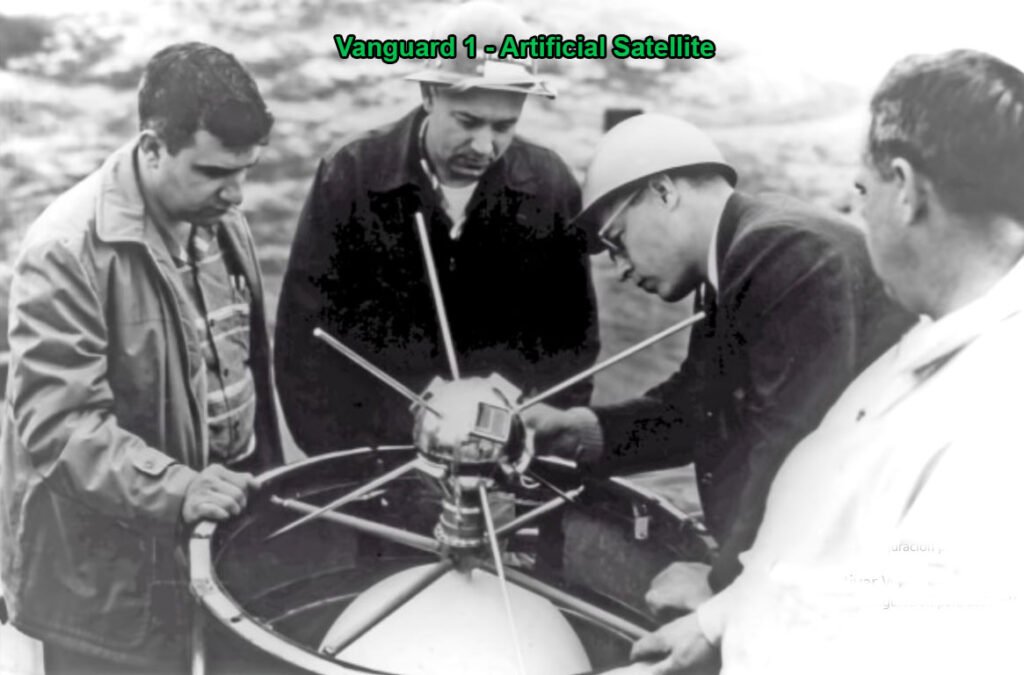
20th Century:
Bell Labs Photovoltaic Effect (1954): Scientists at Bell Labs, including Calvin Fuller, Gerald Pearson, and Daryl Chapin, developed the first practical photovoltaic (PV) cell in 1954. This marked a crucial milestone in the development of solar panels for generating electricity.
Early Space Applications: The space race in the 1960s drove the use of solar panels in space exploration. The Vanguard 1 satellite, launched in 1958, was equipped with solar cells, making it one of the earliest applications of solar power in space.
Solar Cells in Remote Areas: In the 1970s, solar cells began to find applications in powering remote and off-grid areas, such as telecommunications equipment and navigation systems.
Late 20th Century:
Increased Research and Development: Governments and private entities began investing in research and development for solar technology. This led to improvements in efficiency, cost reduction, and the development of new materials.
Grid-Connected Solar Systems: In the 1990s, grid-connected solar systems became more common, allowing homes and businesses to generate electricity using solar panels and feed any excess power back into the grid.
21st Century:
Rapid Growth and Cost Reduction: The 21st century has witnessed tremendous growth in the global solar industry. Technological advancements, economies of scale, and increased manufacturing efficiency have contributed to a significant reduction in the cost of solar panels.
Government Incentives and Policies: Many governments around the world implemented policies and incentives to promote the adoption of solar energy. These include feed-in tariffs, tax credits, and renewable energy targets, which have helped accelerate the deployment of solar panels.
Advancements in Thin-Film and Solar Cell Technologies: Thin-film solar panels and new solar cell technologies, such as perovskite solar cells, have emerged as alternatives to traditional silicon-based solar panels. These innovations aim to improve efficiency, reduce costs, and expand the range of possible applications.
Energy Storage Integration: With the increasing deployment of solar energy systems, there’s a growing emphasis on integrating energy storage solutions, such as batteries. This helps address the intermittent nature of solar power and allows for better utilization of generated energy.
Floating Solar Farms: Innovations in solar technology have led to the development of floating solar farms on bodies of water, offering new possibilities for large-scale solar installations.
The Future of Solar Energy
The future of solar energy looks promising, with ongoing advancements and innovations driving its continued growth and integration into global energy systems. Several key trends and developments are shaping the future of solar energy:
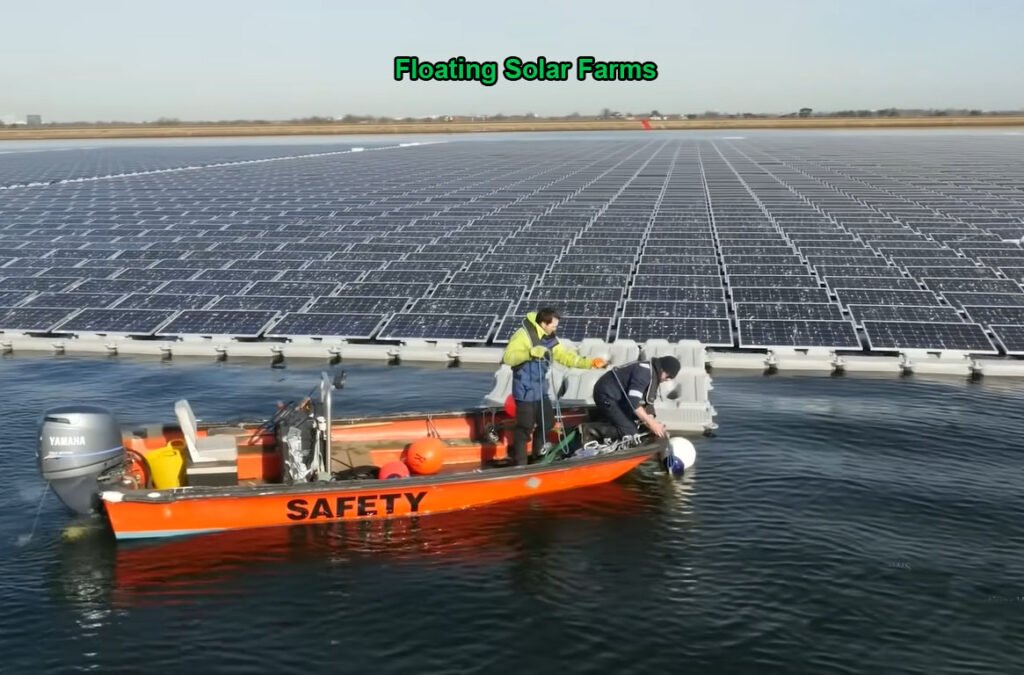
Increased Efficiency and Performance
Emerging technologies, such as tandem solar cells and perovskite-silicon tandem cells, aim to push the limits of solar conversion efficiency beyond traditional silicon-based technologies.
Next Generation Materials
Advances in materials science are contributing to the development of new, cost-effective materials for solar panels. This includes the exploration of organic photovoltaics and other thin-film technologies that offer flexibility and potential applications in diverse settings.
Energy Storage Integration
The integration of advanced energy storage technologies, such as improved batteries and other storage systems, will enhance the reliability and flexibility of solar power, enabling it to meet demand even when the sun is not shining.
Smart Grids and Grid Integration
Advanced grid management systems will enable better integration of solar power into existing electricity grids, providing stability and facilitating the efficient distribution of electricity.
Floating Solar Farms
The concept of floating solar farms on bodies of water, such as lakes and reservoirs, is gaining attention. These installations not only make efficient use of available space but also reduce water evaporation and provide additional benefits in terms of cooling effects on solar panels.
Solar in Urban Environments
Integrated solar solutions within urban environments, such as solar windows, solar-integrated building materials, and solar roadways, are areas of ongoing research. These innovations aim to maximize the use of available space in urban settings for solar energy generation.
Increased Electrification of Transportation
The electrification of transportation, including electric vehicles (EVs) and solar-powered charging stations, will drive the demand for solar energy.
Decentralization and Energy Independence
The future of solar energy is likely to see increased decentralization, with a growing number of homes, businesses, and communities generating their power.
Global Expansion and Market Growth
The global deployment of solar energy is expected to continue expanding. Many countries are setting ambitious targets for renewable energy adoption, and solar power will play a significant role in achieving these goals.
Policy Support and Financing
Governments and businesses worldwide are recognizing the importance of clean energy and are likely to implement policies encouraging the transition to solar power.
Technological Convergence
The convergence of solar energy with other technologies, such as artificial intelligence, blockchain, and the Internet of Things (IoT), is likely to enhance the monitoring, control, and optimization of solar energy systems.
Timeline with the main milestones in the history of solar energy
- 7th Century BCE: The ancient Greeks and Romans use architecture to capture solar energy for heating.
- 1839: Alexandre-Edmond Becquerel discovers the photovoltaic effect.
- 1876: William Grylls Adams and Richard Evans Day discover that selenium produces electricity when exposed to light.
- 1883: Charles Fritts creates the first solar cell by coating selenium with a thin layer of gold.
- 1954: Bell Labs develops the first practical photovoltaic (PV) cell using silicon.
- 1958: Vanguard 1, the first solar-powered satellite, is launched.
- 1970s: Solar-powered calculators and small electronic devices become commercially available.
- 1980s: The U.S. and other countries start implementing policies and incentives to promote solar energy.
- 1990s: Grid-connected solar systems become more common; Germany introduces feed-in tariffs.
- 2001: The International Energy Agency (IEA) establishes the Photovoltaic Power Systems Programme (PVPS).
- 2004: The U.S. Department of Energy launches the Solar America Initiative.
- 2008: The first feed-in tariff for solar power is introduced in Ontario, Canada.
- 2010s: Rapid growth in solar installations globally; costs of solar panels continue to decline.
- 2015: The International Solar Alliance (ISA) is launched to promote solar energy in 121 countries.
- 2016: Solar becomes the cheapest form of new electricity in many parts of the world.
- 2018: China surpasses 175 GW of installed solar capacity, becoming a global leader.
- 2020s: Continued growth in solar installations; increased focus on energy storage and solar-plus-storage solutions.
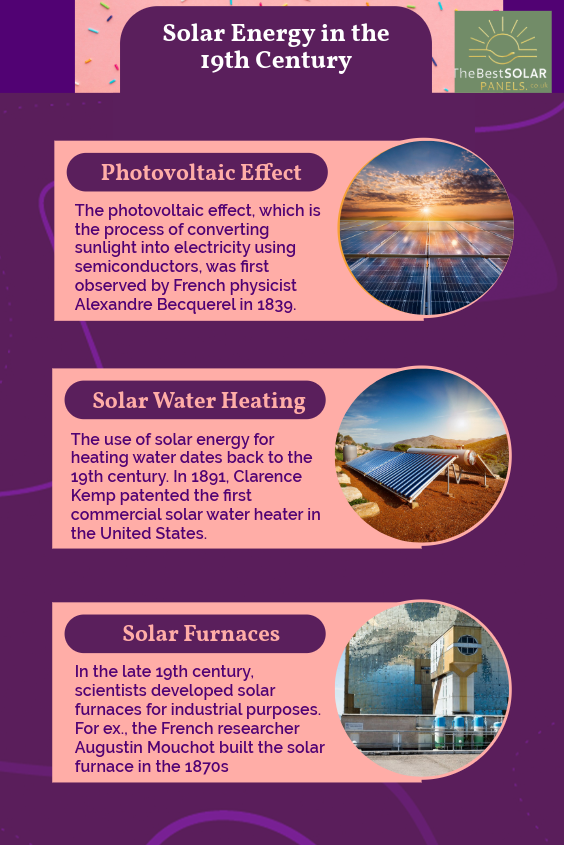
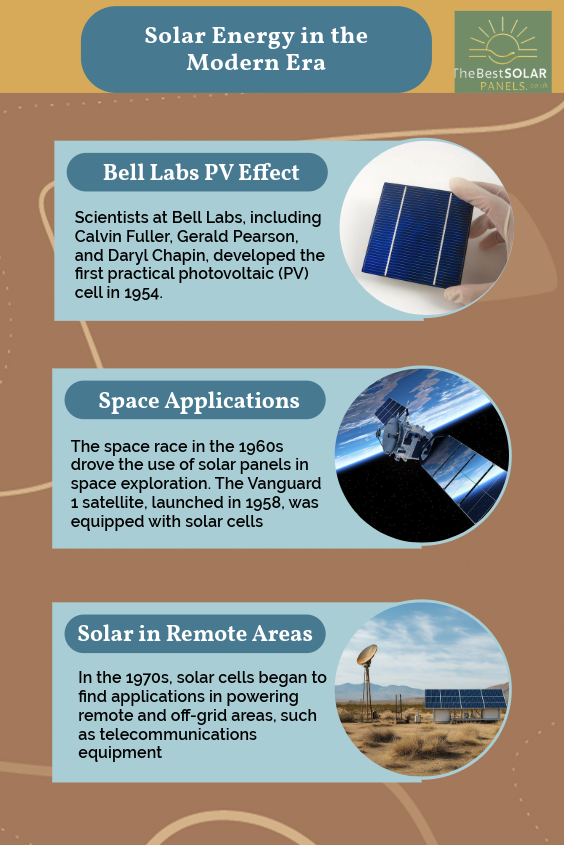



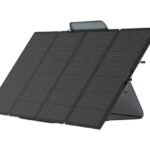
Leave a Reply